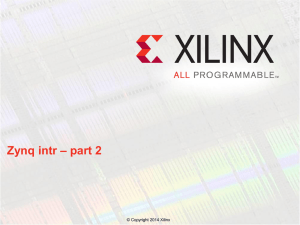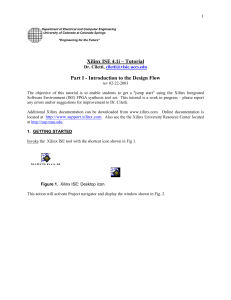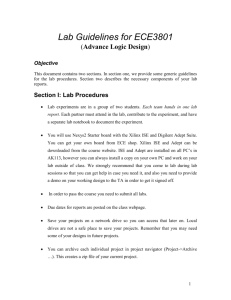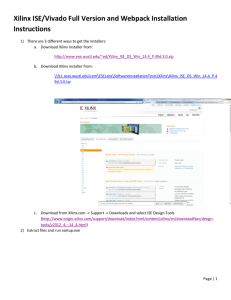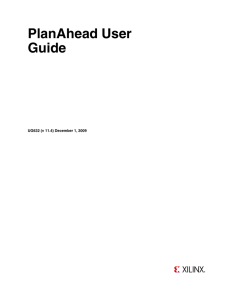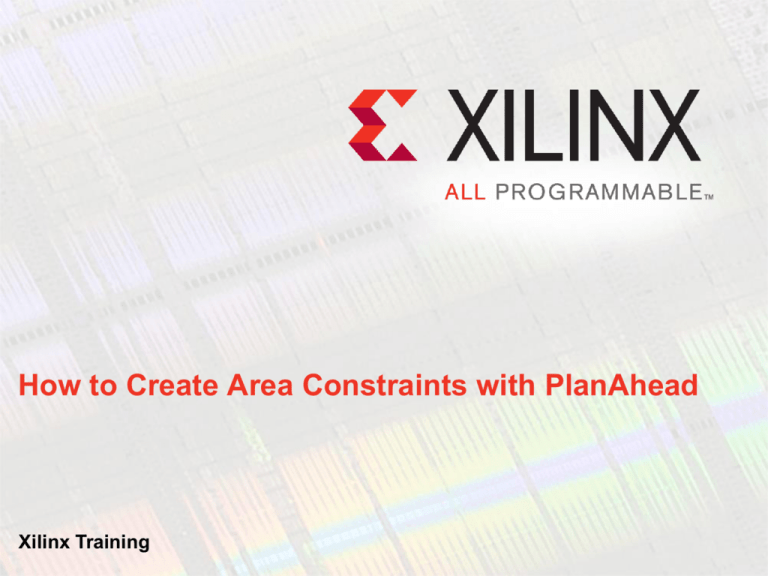
How to Create Area Constraints with PlanAhead
Xilinx Training
Objectives
After completing this module, you will be able to:
Add Pblocks to your design with the Hierarchy viewer, Schematic
viewer, and the Timing Report generator
Pblocks
Pblocks are used to group logic
– Assignment of a Pblock to a range of locations on the die makes it an area
constraint
– When starting to floorplan, the intent is to minimize the routing between
Pblocks
– A single Pblock should not occupy over 20 percent of the design resources
– If so, try to make two Pblocks from logic at a lower level
UCF Syntax
Pblocks are used to group logic
Pblocks form a group
– INST "usbEngine1" AREA_GROUP = "pblock_usbEngine1";
Area constraints form a range constraint
– AREA_GROUP "pblock_usbEngine1“ RANGE=SLICE_X0Y60:SLICE_X43Y119;
Making a Pblock
To create a Pblock
– Select a level of hierarchy or a
component from the Netlist
window and use the popup
menu > New Pblock
– Select a block from the
Hierarchy viewer and use the
popup menu > New Pblock
command
– From a timing report, use the
popup menu > New Pblock
command
Auto-create Pblock
From the horizontal toolbar use the
Tools > Auto-create Pblocks
command
If more modules exist than the total
number of Pblocks specified, it will
create Pblocks for the largest
modules
Device Viewer
Create or view Pblocks easily using
the Device viewer.
The vertical toolbar has the
following controls
– Show/Hide I/O Nets
– Show/Hide Bundle Nets
– Show/Hide Loc Constraints
– Show connections for selected
instances
– Draw Pblock
Pblock Properties
After selecting a Pblock use the
popup menu > Pblock Properties
command
– Shows device utilization of Pblock
•
•
•
•
•
CLB
Block RAM
DSP slice
Number of clocks
Best way to determine
Analyzing Connectivity
Use the Show Connectivity popup
menu command to identify
– Widely dispersed routing
– Tightly clumped logic modules
Use Shift-click to select source and
destination logic
– Use the popup menu > Show Connectivity
command
You can use this command
sequentially to expand a cone of logic
Analyzing Timing Results
Examine your timing results
– Generated timing reports make it easy to display all
or some paths that are failing to meet a timing
constraint
•
•
•
Helps you see patterns
Simply select the paths to be displayed from the
report or use Shift + click to select a group of paths
To remove, reselect the group and click the
Hide All Timing Paths button from
the vertical toolbar
– After selecting a path use the
popup menu > View Path Report
command to see a more detailed
timing report
Analyzing Timing Results with the Schematic
View critical paths with the
Schematic viewer
– Select the path(s) and use the popup
menu > Schematic command
– Helps you visualize the levels of
hierarchy
– Analyze logic modules for floorplanning
– Create Pblocks from selected modules
– Use the popup menu > Select Primitive
Parents command to select the
smallest modules containing all of the
selected primitives
Visualizing Hierarchy
Hierarchy view displays logic
hierarchy
– Visualize relative size and
location of selected logic in
Hierarchy view
– Easily select parent modules
of selected logic to floorplan
– Use the popup menu > Show Hierarchy command to view a selected
module with this view
– Note that this only shows size; it does not show how many signals
are connected between the modules
– Likewise, after selecting a component, use the popup menu > New
Pblock command to assign the logic
Case Study
Design has been implemented
with no area constraints
Import the design into the
PlanAhead™ software and
perform a timing analysis
– Display all of the paths that are
failing to meet timing to get ideas
– Note the hierarchical blocks that are
part of the failing paths
– In this example, note that there are
long routing delays between some
of the block RAMs
Case Study
Failing paths displayed with the
Schematic viewer
– Confirmed from the timing reports
that most of these paths can be
constrained within a few area
constraints
– In this case, usbEngine1 is a
good candidate, but there may be
others
Case Study
Placement reviewed in
the Device view
– Timing critical nets and
logic in green (20% of
design)
– Note the use of block
RAM
•
Is there anything
wrong?
– Note the pin layout
•
Is there anything
wrong?
Case Study
Top-level floorplan examined
(this is just Pblocks with no
area constraints)
3
4
– These will have to be made
by the user and are based on
the design hierarchy
•
The white box is usbEngine1
– Note the green lines
•
•
These are the connections
from logic to I/O pins
Is there anything wrong?
2
5
– Note the red lines
•
•
They represent the greatest
concentration of routes
between hierarchical blocks
Where should each Pblock
go?
1
6
Case Study
If all the timing errors
were only in usbEngine1,
then an area constraint
for Pblock 5 might be
able to be made
3
4
– Saves some work
The block RAMs and DSP
slices within usbEngine1
could also be placed in
the upper left corner of
the die
– This would in effect force
the tools to place the logic
closer to its I/O pins
2
5
1
6
Case Study
There were also timing
errors in the usbEngine0
component
– In the end, this also
required similar
floorplanning
So the final solution is
shown here
UCF Syntax
The following constraints are the output of this exercise
– INST "usbEngine1" AREA_GROUP = "pblock_usbEngine1";
– AREA_GROUP "pblock_usbEngine1" RANGE=SLICE_X0Y60:SLICE_X43Y119;
– AREA_GROUP "pblock_usbEngine1" RANGE=DSP48_X0Y24:DSP48_X2Y47;
– AREA_GROUP "pblock_usbEngine1" RANGE=RAMB18_X0Y24:RAMB18_X2Y47;
– AREA_GROUP "pblock_usbEngine1" RANGE=RAMB36_X0Y12:RAMB36_X2Y23;
List of Questions (Revisited)
In hindsight, maybe there could have been a few more questions
– Were proper pin planning decisions made?
– Is there any central logic that needs to be placed in the middle of the die?
– Are all my area constraints touching appropriately?
– Should any of my area constraints be used to place logic near dedicated
hardware (such as GTs, the PCI core, or memory controllers, for example)?
Summary
Pblocks
– Are used to group logic
– Support a user-programmable utilization
•
•
90%+ for low speed
70–87% for high speed
There are a number of utilities in the PlanAhead software that
can help you make good area constraints
– Hierarchy viewer, Schematic viewer, and Timing Report generator
– Automatic Pblock assignment and placement
More Information
To learn more, visit the PlanAhead tool web site
www.xilinx.com/planahead
– Articles, documentation, white papers, and training enrollment
User Guide
– PlanAhead Software Tutorial, Design Analysis and Floorplanning for
Performace, UG676
– Floorplanning Methodology Guide, UG633
View the PlanAhead tool video demonstrations
– Quick Tour of the PlanAhead Design and Analysis Tool
– I/O pin planning with PinAhead Technology
– Improve Design Performance with the PlanAhead Design and Analysis tool
Where Can I Learn More?
Xilinx Education Services courses
– www.xilinx.com/training
• Xilinx tools and architecture courses
• Hardware description language courses
• Basic FPGA architecture, Basic HDL Coding Techniques, and other free
Videos!
Trademark Information
Xilinx is disclosing this Document and Intellectual Property (hereinafter “the Design”) to you for use in the development of designs to operate on,
or interface with Xilinx FPGAs. Except as stated herein, none of the Design may be copied, reproduced, distributed, republished, downloaded,
displayed, posted, or transmitted in any form or by any means including, but not limited to, electronic, mechanical, photocopying, recording, or
otherwise, without the prior written consent of Xilinx. Any unauthorized use of the Design may violate copyright laws, trademark laws, the laws of
privacy and publicity, and communications regulations and statutes.
Xilinx does not assume any liability arising out of the application or use of the Design; nor does Xilinx convey any license under its patents,
copyrights, or any rights of others. You are responsible for obtaining any rights you may require for your use or implementation of the Design.
Xilinx reserves the right to make changes, at any time, to the Design as deemed desirable in the sole discretion of Xilinx. Xilinx assumes no
obligation to correct any errors contained herein or to advise you of any correction if such be made. Xilinx will not assume any liability for the
accuracy or correctness of any engineering or technical support or assistance provided to you in connection with the Design.
THE DESIGN IS PROVIDED “AS IS" WITH ALL FAULTS, AND THE ENTIRE RISK AS TO ITS FUNCTION AND IMPLEMENTATION IS WITH
YOU. YOU ACKNOWLEDGE AND AGREE THAT YOU HAVE NOT RELIED ON ANY ORAL OR WRITTEN INFORMATION OR ADVICE,
WHETHER GIVEN BY XILINX, OR ITS AGENTS OR EMPLOYEES. XILINX MAKES NO OTHER WARRANTIES, WHETHER EXPRESS,
IMPLIED, OR STATUTORY, REGARDING THE DESIGN, INCLUDING ANY WARRANTIES OF MERCHANTABILITY, FITNESS FOR A
PARTICULAR PURPOSE, TITLE, AND NONINFRINGEMENT OF THIRD-PARTY RIGHTS.
IN NO EVENT WILL XILINX BE LIABLE FOR ANY CONSEQUENTIAL, INDIRECT, EXEMPLARY, SPECIAL, OR INCIDENTAL DAMAGES,
INCLUDING ANY LOST DATA AND LOST PROFITS, ARISING FROM OR RELATING TO YOUR USE OF THE DESIGN, EVEN IF YOU HAVE
BEEN ADVISED OF THE POSSIBILITY OF SUCH DAMAGES. THE TOTAL CUMULATIVE LIABILITY OF XILINX IN CONNECTION WITH
YOUR USE OF THE DESIGN, WHETHER IN CONTRACT OR TORT OR OTHERWISE, WILL IN NO EVENT EXCEED THE AMOUNT OF
FEES PAID BY YOU TO XILINX HEREUNDER FOR USE OF THE DESIGN. YOU ACKNOWLEDGE THAT THE FEES, IF ANY, REFLECT
THE ALLOCATION OF RISK SET FORTH IN THIS AGREEMENT AND THAT XILINX WOULD NOT MAKE AVAILABLE THE DESIGN TO YOU
WITHOUT THESE LIMITATIONS OF LIABILITY.
The Design is not designed or intended for use in the development of on-line control equipment in hazardous environments requiring fail-safe
controls, such as in the operation of nuclear facilities, aircraft navigation or communications systems, air traffic control, life support, or weapons
systems (“High-Risk Applications”). Xilinx specifically disclaims any express or implied warranties of fitness for such High-Risk Applications. You
represent that use of the Design in such High-Risk Applications is fully at your risk.
© 2012 Xilinx, Inc. All rights reserved. XILINX, the Xilinx logo, and other designated brands included herein are trademarks of Xilinx, Inc. All
other trademarks are the property of their respective owners.


